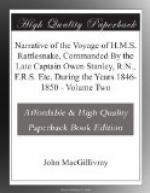With regard to the curious burial ceremonies of the Kowraregas, I regret that I cannot be so explicit as might otherwise have been the case, as Giaom’s information on this subject, and on this only, was not written down at the time. When the head of a family dies at Muralug, the body is laid out upon a framework of sticks raised a foot from the ground, and is there allowed to rot. A small hut is raised close by, and the nearest relative of the deceased lives there, supplied with food by his friends, until the head of the corpse becomes nearly detached by the process of putrefaction, when it is removed and handed over to the custody of the eldest wife. She carries it about with her in a bag during her widowhood, accompanying the party of the tribe to which she belongs from place to place. The body, or rather the headless skeleton, is then interred in a shallow grave over which a mound is raised ornamented by wooden posts at the corners painted red, with sometimes shells, and other decorations attached to them, precisely such a one as that figured in the Voyage of the Fly, volume 1 page 149. On the occasion of our visiting the grave in question (at Port Lihou, on Muralug) Giaom told me that we were closely watched by a party of natives who were greatly pleased that we did not attempt to deface the tomb; had we done so—and the temptation was great to some of us, for several fine nautilus shells were hanging up, and some good dugong skulls were lying upon the top—one or more of the party would probably have been speared.
CHAPTER 2.2.
Sail from Cape York.
Mount Ernest described.
Find Kalkalega tribe on Sue Island.
Friendly reception at Darnley Island, and proceedings
there.
Bramble Cay and its turtle.
Stay at Redscar Bay.
Further description of the natives, their canoes,
etc.
Pass along the South-east coast of New Guinea.
Call at Duchateau Islands.
Passage to Sydney.
Observations on Geology and Ethnology.
Origin of the Australians considered.
Sail from Cape York.
December 3rd.
At length we have bade a final adieu to Cape York, after a stay of upwards of two months, which have passed away very pleasantly to such of us as were in the habit of making excursions in the bush, or who spent much of their time on shore. We are now on our way to Sydney, by way of Torres Strait, New Guinea and the Louisiade, chiefly for the purpose of running another set of meridian distances, the position of Cape York being now sufficiently well determined to serve as a secondary meridian, one of the starting points of the survey. The natives learned at daylight that we were to leave them in a few hours, so in order to make the most of their last opportunity of getting bisiker and choka, they hauled a large canoe across the dry sands after much trouble, and under the direction of Baki, who affected great grief at the prospect of parting with us, went off to the ship.




